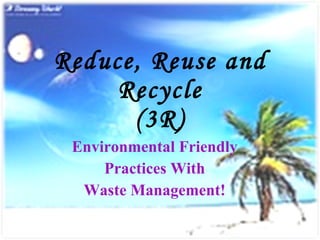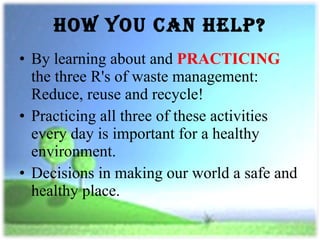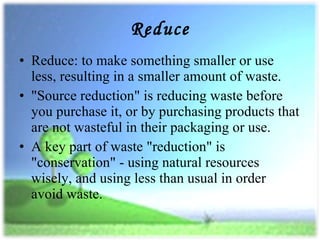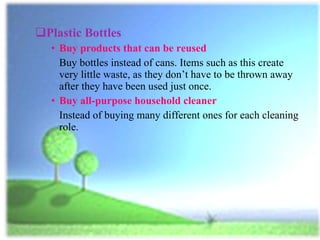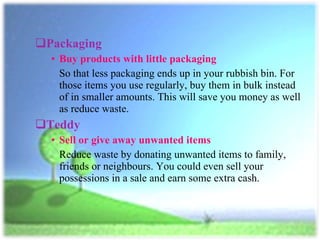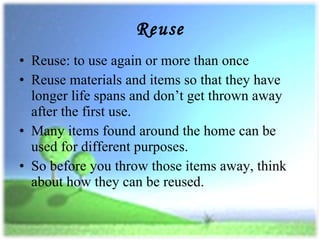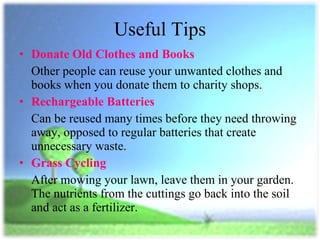Reduce, Reuse and Recycle (3R)
- 1. Reduce, Reuse and Recycle (3R) Environmental Friendly Practices With Waste Management!
- 2. Think about this three ways:- Reduce the amount of the Earth's resources that we use. Reuse Don't just bin it, could someone else make use of it? Recycle Can the materials be made into something new?
- 3. How You Can Help? By learning about and PRACTICING the three R's of waste management: Reduce, reuse and recycle! Practicing all three of these activities every day is important for a healthy environment. Decisions in making our world a safe and healthy place.
- 4. Reduce Reduce: to make something smaller or use less, resulting in a smaller amount of waste. "Source reduction" is reducing waste before you purchase it, or by purchasing products that are not wasteful in their packaging or use. A key part of waste "reduction" is "conservation" - using natural resources wisely, and using less than usual in order avoid waste.
- 5. You can reduce the amount of waste you create by choosing what rubbish you throw away. This can be easy and fun - just follow the simple guidelines to reduce your waste at home, school or work.
- 6. What to buy and How to use it? Crush Shopping Waste reduction starts at the supermarket. By making slight alterations to your shopping list you can significantly reduce the amount of waste created in and around the home. Goods Buy only what you need Reduce unnecessary waste by avoiding those pointless purchases. Items that rarely get used can be borrowed or shared with others.
- 7. Plastic Bottles Buy products that can be reused Buy bottles instead of cans. Items such as this create very little waste, as they donŌĆÖt have to be thrown away after they have been used just once. Buy all-purpose household cleaner Instead of buying many different ones for each cleaning role.
- 8. Packaging Buy products with little packaging So that less packaging ends up in your rubbish bin. For those items you use regularly, buy them in bulk instead of in smaller amounts. This will save you money as well as reduce waste. Teddy Sell or give away unwanted items Reduce waste by donating unwanted items to family, friends or neighbours. You could even sell your possessions in a sale and earn some extra cash.
- 9. Unwanted Mail/Letter Reduce paper waste by cancelling unwanted mail You can unsubscribe to many national mailing lists by contacting them.
- 10. Think Before You Throw Crush Throwing Many of the items that you would normally consider as rubbish could be used for other purposes. So instead of throwing items away, reduce waste by using them for other roles. Mail Papers and envelopes Can used as scrap paper in making notes.
- 11. Cardboard Box Cardboard, Newspaper and Bubble Wrap Can be used as packing materials. Packaging products, such as foil and egg cartons, can be used for art projects in schools and nurseries. Jars and Pots Can be used as small containers to store odds and ends. Plastic and Paper Bags Can be reused in the shops, used as bin bags around the house or as wrapping paper.
- 12. Reuse Reuse: to use again or more than once Reuse materials and items so that they have longer life spans and donŌĆÖt get thrown away after the first use. Many items found around the home can be used for different purposes. So before you throw those items away, think about how they can be reused.
- 13. How to reuse those everyday bits and pieces? Carrier bags and twist ties Carrier bags can be reused in the shops or as bin bags around the house. Paper bags make useful wrapping paper and twist ties can be used to secure loose items together, such as computer wires.
- 14. Envelopes By sticking labels over the address you can reuse envelopes. Alternatively, old envelopes can be used as scrap paper to make notes on. Jars and pots Can use them as small containers to store odds and ends.
- 15. Newspaper, cardboard and bubble wrap Make useful packing material when moving house or to store items. Old clothes Can be made into other textile items such as cushion covers. Scrap paper Can be used to make notes and sketches. Don't forget to recycle it when you no longer need it.
- 16. Tyres Old tyres can be given to your local petrol station where they will be recycled. Or you could make a tyre-swing by tying a strong rope around a tyre and attaching it to a tree. Used wood Can be used in woodcrafts for making objects such as a spice rack or a bird table. Alternatively it could be used as firewood.
- 17. Useful Tips Donate Old Clothes and Books Other people can reuse your unwanted clothes and books when you donate them to charity shops. Rechargeable Batteries Can be reused many times before they need throwing away, opposed to regular batteries that create unnecessary waste. Grass Cycling After mowing your lawn, leave them in your garden. The nutrients from the cuttings go back into the soil and act as a fertilizer.
- 18. Recycle Recycle: to convert materials/waste into reusable material Landfills are full of items that could be recycled. Recycling puts objects through a process that allows them to be used again.
- 19. BENEFITS OF Recycle Recycling reduces the need for land filling and incineration Recycling prevents pollution Recycling saves energy Recycling decreases emissions of greenhouse gases that contribute to global climate change Recycling conserves natural resources Recycling helps sustain the environment for future generations
- 20. Recycle Brown- Glass Blue- Paper Orange- Aluminium and Plastic Bottles
